Spectacles are the Anti-Glass
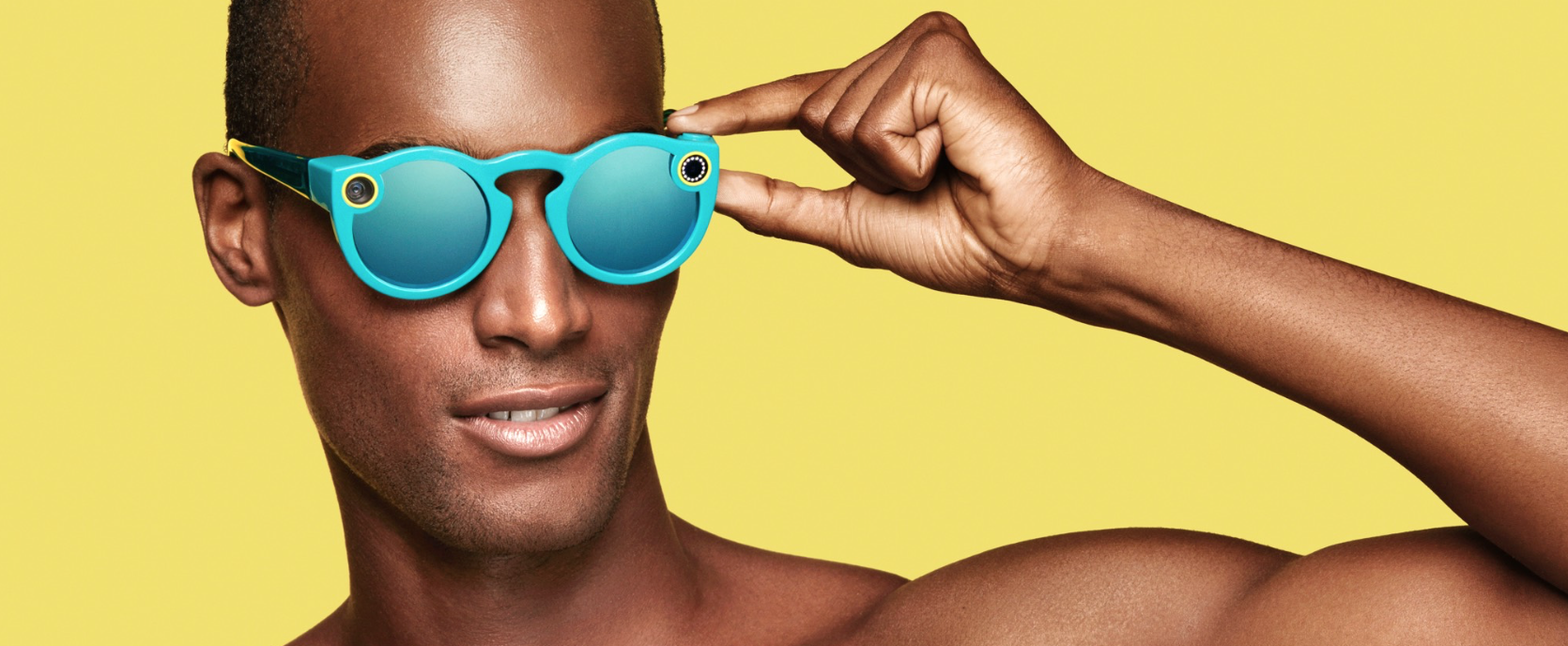
…and they’ll succeed where Google stumbled
Snapchat announced Spectacles, their first hardware product, last Friday evening. Despite being the first hardware effort from our* *current social darlings, Evan Spiegel and company seem to be playing down the product. In a Wall Street Journal feature on Snap, only a handful of paragraphs touch on Spectacles. One section sandbags the entire effort:
For the moment, Spectacles appears to be a bit of a lark. At a price of $129.99 and with limited distribution, it won’t be relied upon for significant immediate revenue. Spiegel refers to it as a toy, to be worn for kicks at a barbecue or an outdoor concert — Spectacles video syncs wirelessly to a smartphone, making it easily shareable. “We’re going to take a slow approach to rolling them out,” says Spiegel. “It’s about us figuring out if it fits into people’s lives and seeing how they like it.”
If you ignore the Karl Lagerfeld portraits of Spiegel, the whole affair is rather low key.
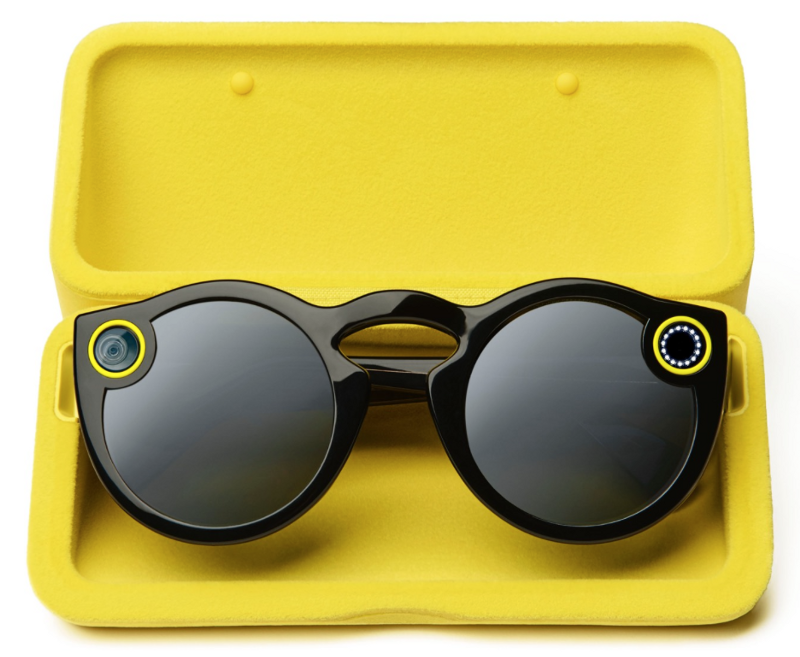 And who can blame them? Launching digital glasses anywhere in California forces comparison’s to Google Glass, a device whose massive, life changing promises were never delivered. Glass’ launch video was an augmented reality what-if followed by an initial live demo by skydivers, then a Diane Von Furstenburg catwalk appearance.
And who can blame them? Launching digital glasses anywhere in California forces comparison’s to Google Glass, a device whose massive, life changing promises were never delivered. Glass’ launch video was an augmented reality what-if followed by an initial live demo by skydivers, then a Diane Von Furstenburg catwalk appearance.
Compared to Glass as promised by Google, Spiegel’s “toy” for a “barbeque or an outdoor concert” is rather mundane.
But that’s OK.
I think Spectacles could not only succeed, but turn out to be a watershed product for Snap. Here’s why:

Spectacles Side-Step Glass’ Cultural Challenges
Despite their high technical goals, Glass’ biggest challenge was cultural. Google focused so closely on the users of Glass that they forgot everyone around them, leading to the design of an anti-social product. I cover this in detail here, but in a nutshell:
Glass’ screen is visible only to it’s user and it’s camera looks out documenting everything except the user, storing content to be shared at the user’s discretion. I believe that these always on, core functions of Glass will prevent it from being welcomed in social settings. Those around the Glass users must implicitely trust the Glass wearer, for they have no idea where the Glass user’s current attention lies and cannot visually confirm whether or not they are currently being captured by Glass.
Google is working so hard to keep technology out of the way that they’re forgetting why it’s important to seetechnology when it’s present.This challenge was clearly considered by the team at Snap, because they made several choices which address it directly. They added a bright light to show others you’re recording. They limited video to 10 second clips, not persistent documentation. And, most importantly, they made Spectacles sunglasses.
Sunglasses are worn occasionally. Sunglasses aren’t worn inside. Everyone wears sunglasses. Sunglasses make sense during public, fun times. Wear sunglasses inside and you’re considered “that guy,” no onboard camera required. Choosing sunglasses specifically tightly confines Spectacles’ use cases to social acceptable contexts. Spectacles work within cultural norms rather than attempt to redefine them.
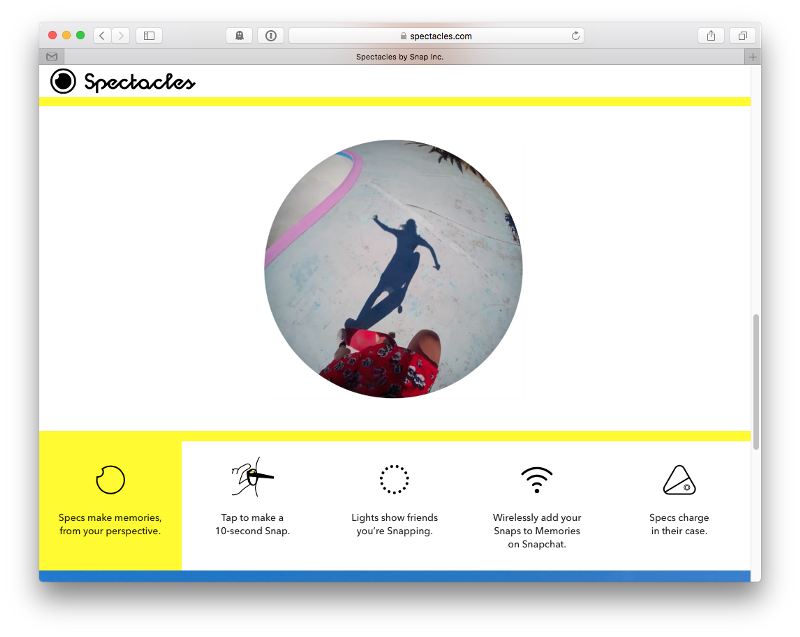
Spectacles have Job-sian Focus
Like Job’s Apple, Snap is prioritizing focus and simplicity above all.
Above is Spectacles’ website. Everything we need to know about Spectacles (save the design and colors, which greets the user prior) is listed here. The promise, “Specs make memories from your perspective,” is simple and clear.
Compare the above to the website for the first iPod:
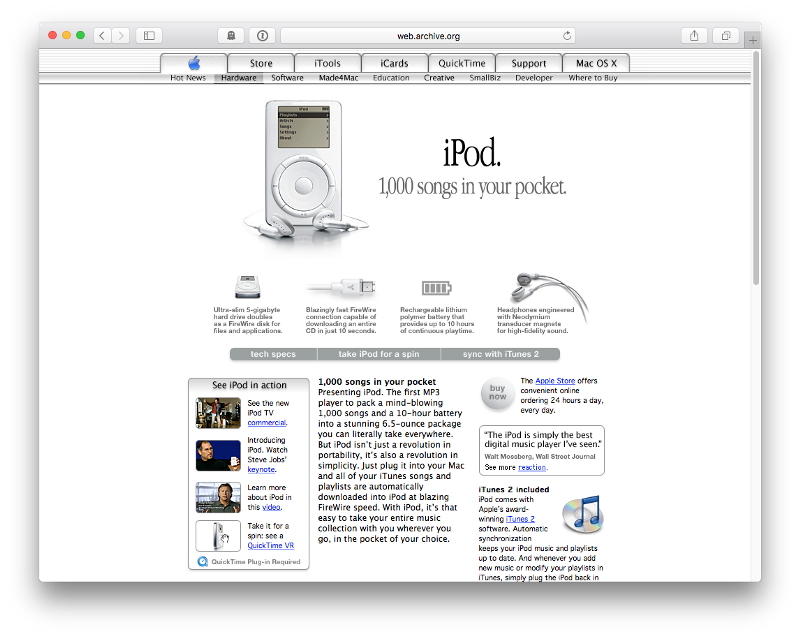 Same succinct five points, including one clear promise: “1,000 songs in your pocket.” This clear promise or vision was made for every Apple product that wasn’t a computer (Watch excepted).
Same succinct five points, including one clear promise: “1,000 songs in your pocket.” This clear promise or vision was made for every Apple product that wasn’t a computer (Watch excepted).
Sure, this seems like best practice, but nearly every tech product which attempts to invent a category ignores this advice.
Glass shouldn’t have promised an augmented life, just better memories.
Alexa shouldn’t have promised household AI, just music on-demand. (Sure, Alexa’s doing OK, but compare the iPod and Spectacles sites above to Alexa’s homepage. Very different!)
Beyond shared restraint, Specs and the iPod both feel/felt like experiments. They’re odd, but inoffensive, and I bet Specs have similarly underwhelming sales. They’ll do fine, but won’t light the world on fire. As Spiegel said, “We’re going to take a slow approach to rolling them out. It’s about us figuring out if it fits into people’s lives and seeing how they like it.”
When Snap Finds the Formula, Spectacles will be Everywhere
Specs are $129.99. Stock Ray-Bans are $150. Specs are already cheap enough for a fashion item. The electronic components are even cheaper.
We’ll have to wait for a proper teardown, but Specs probably contain Bluetooth, a dab of storage for a few shots, several chips to run the whole thing, and a cellphone camera from several years ago. (Another benefit to making them sunglasses? The camera only needs to work in brightlight.) This package is already cheap and will only get cheaper.
If Snap cracks the code and figures out this can fit in the fun parts of people’s lives, expect this kit to propagate everywhere. I wouldn’t be surprised if the salesperson at LensCrafters asks you if you’d like your sunglasses with Specs, right after asking about anti-glare coating.
Snap will pursue a good price point and small sizes before they add a second camera for VR recording. VR will come after Snap cracks the cultural code for sharing videos with Specs and when there’s a way for people to consumer VR video at scale.
(What will also be fun to watch: all the Shenzhen knockoffs. Everything in Specs can be sourced from the warehouses of smartphone parts in Southeast China. Expect clones for <$100 in under three months. But Snap shouldn’t worry that: these won’t be as simple or connected to a giant network.)
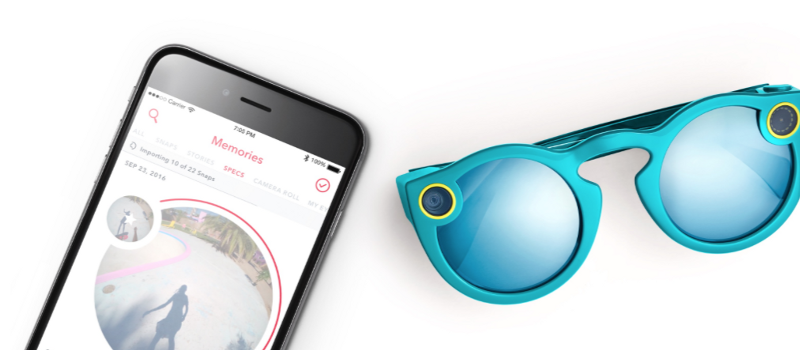
Snap Wants to be the Heir to Kodak
Specs, and the way Spiegel talks about them, is classic Kodak. They make “memories”, not videos. You can almost hear Don Draper. Capturing and sharing memories is great terrain, proven to be an insanely large market, with no dominant leader.
Facebook has irons in the fire and isn’t in the brand ballpark: Facebook is about communication, not memories.
Jobs aimed Apple in this direction with his Digital Hub strategy. But Apple veered away from the hub and diluted focus with the Watch.
Google is being Google. Photos is great, but it and the rest of Google’s offering is about intelligent discovery, not memories.
Spiegel has taken aim:
He’s studied the histories of firms like Kodak and Polaroid and how they pitched themselves to the public. “First it was make a photo,” Spiegel says, characterizing the way people would visit a studio akin to the one we’re in now for a formal sitting. “Then it was take a photo,” as portable cameras let people capture casual snapshots. “And finally it became give a photo,” starting with instant Polaroids handed to friends at a party and evolving into smartphone cameras that let you zip your selfie to anyone on the planet.
Snap Just Threw a Bomb in the Action Cam Market
Snap just took a specialty product and showed how it might become mass. Not an epic camera for epic people during epic times, but a fun camera for fun people during fun times.
Which market would you rather have?
(By the way, head down to Times Square in December and look for tourists with GoPros strapped to their chest. Opportunity often looks like lots of people doing awkward things.)
(Another awkward behavior? People with GoPros and drones spending entire plane flights trying to edit down their streams into something actually consumable. That 10-second limit is a smart choice by Snap.)
Snap has the Best Brief in the World Right Now
Snapchat has a massive audience of people who use the app to have fun and share that fun. It must be exciting to wake up every morning, tasked with figuring out how to deliver on that promise.
I’ll admit, I’ve been a Snapchat skeptic for a bit now. I didn’t buy the VR/AR argument, as photo filters are rather simple and a very constrained challenge. And Facebook’s continued dominance in social looked immovable.
But Specs crystalizes what Snap stands for in a way I hadn’t realized prior.
A friend at Snap responded to this remark, sent via text, very quickly: “It’s funny, Evan’s been preaching this stuff for years. Just takes one story or product to bring it all together.”
